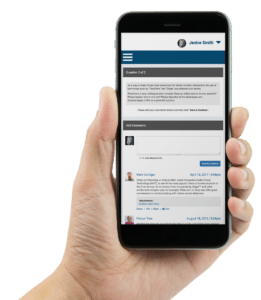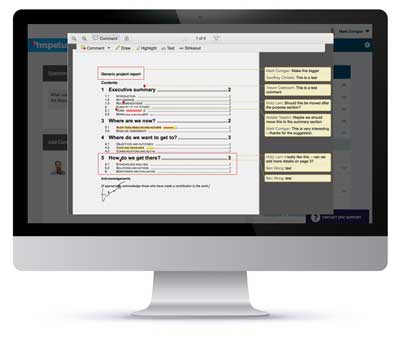Mobile phones are both a blessing and a curse. Why, you ask? Well, because they represent the paradox of modern day life—the illusion of being both “everywhere” and “nowhere” at the same time. Everywhere, because at the click of a button, we can be transported into our office, a discussion forum, an online working group, our child’s classroom, or an online spinning class—all at the same time. Nowhere, because our attention can be so scattered over the internet that we are never really “here” in the now. The great paradox of mobile proximity.
The Power of Mobile Proximity
Mobile proximity allows people to work virtually and participate in meetings from anywhere in the world. Global work teams, which were once only graced upon corporations who could afford expensive flights and technologies to coordinate workgroups, is now available to any sized organization. It is a luxury that can now be afforded by the most basic startup. In fact, it is the fuel that allows any new company to actually thrive and grow in today’s super accelerated market. Mobile proximity is as common today as the morning commute was a decade ago.
T he ability to “be everywhere” simultaneously, with instantaneous communication with people in different locations, is often referred to as “ubiquitous interactions”. One interesting question is: what does this mean for work environments? Mobile proximity ultimately enables virtual communication. We see this with Facebook comments, Twitter posts, and Instagram selfies. Communication is fast and unimpressed. Straight to the point. But can mobile proximity offer possibilities for knowledge collaboration in the workplace? What impact does and can it provide for joint virtual problem-solving and knowledge production?
he ability to “be everywhere” simultaneously, with instantaneous communication with people in different locations, is often referred to as “ubiquitous interactions”. One interesting question is: what does this mean for work environments? Mobile proximity ultimately enables virtual communication. We see this with Facebook comments, Twitter posts, and Instagram selfies. Communication is fast and unimpressed. Straight to the point. But can mobile proximity offer possibilities for knowledge collaboration in the workplace? What impact does and can it provide for joint virtual problem-solving and knowledge production?
Mobile Proximity in Action
To answer these questions, we can start with a platform that plays an important role in most people’s lives: Wikipedia. This is an open platform that acts as a free online encyclopedia where people actively contribute and edit content. Contributors interact consistently with other people across the globe whom they do not know or speak with on a regular basis. There is only written shared content and nobody actually “speaks” to anyone in “real time”. Yet, because of the shared intent to keep Wikipedia alive, relevant, and accurate, they collaborate with a shared vision and mission.
We also see this joint knowledge collaboration and ubiquitous online interactions through platforms such as Github. GitHub is a web-based hosting service that allows individuals from around the world to contribute source code and version control for open-source software projects. It provides access control and several collaboration features such as bug tracking, feature requests, task management, and wikis. The platform has almost 20 million users and over 57 million repositories. It’s another great example of how ubiquitous interactions through mobile proximity amidst complete “strangers” can result in virtual problem-solving and knowledge production.
 As a third example, we have observed knowledge collaboration in private company portals such as the Impetus InSite Platform. Pharmaceutical companies can create privately branded, password-protected online portals where they can engage with customer stakeholders through virtual advisory boards or working groups. Advisors can engage in asynchronous online activities through discussion forums such as InSite Exchange™ or through annotation exercises, to comment, provide insights, share with colleagues, and annotate documents. With mobile proximity, advisors from across the country can co-create consensus papers, journal articles, market access submissions, or medical education materials. Further, through these ubiquitous interactions, customer advisors can collaborate virtually from anywhere in the world to build knowledge banks.
As a third example, we have observed knowledge collaboration in private company portals such as the Impetus InSite Platform. Pharmaceutical companies can create privately branded, password-protected online portals where they can engage with customer stakeholders through virtual advisory boards or working groups. Advisors can engage in asynchronous online activities through discussion forums such as InSite Exchange™ or through annotation exercises, to comment, provide insights, share with colleagues, and annotate documents. With mobile proximity, advisors from across the country can co-create consensus papers, journal articles, market access submissions, or medical education materials. Further, through these ubiquitous interactions, customer advisors can collaborate virtually from anywhere in the world to build knowledge banks.
Defining Mobile Ubiquity
Ubiquitous mobile connectivity assumes movement in either spatial, temporal, and/or contextual dimensions. Spatial mobility refers to geographical or physical movements of objects (ie. people, data, or images). Temporal mobility refers to movement that allows time to be ordered, divided, and reconfigured in different, nonlinear ways. Contextual mobility refers to both the situatedness of interaction as well as the transcending of traditional physical and spatial boundaries (ie. home lives vs work lives). All of these leverage technology to transcend space, time, and context. his, in turn, impacts our individual attention, participation, decision-making, and relationships.
With technology, parallel activities can be done “simultaneously”, overcoming the traditional temporal boundaries of previous generations. Activities that once occurred concurrently or in a sequence of steps (ie. information gathering, dissemination, discussion, deliberation, and deciding) can now be performed at the same time.
 This can be a good thing, as it reduces the time it takes to “get things done”. The “not so good” in this, however, is that it encourages excessive “multi-tasking” or the temptation to do so since it is just too easy not to. Research has found that the human brain has not evolved enough to focus on two difficult tasks at the same time. Doing this only depletes our will power, reduces our overall effectiveness on each of the tasks, and decreases our overall well-being. Technology can accelerate life progresses but also depress productivity, flow states, and overall happiness if not managed appropriately.
This can be a good thing, as it reduces the time it takes to “get things done”. The “not so good” in this, however, is that it encourages excessive “multi-tasking” or the temptation to do so since it is just too easy not to. Research has found that the human brain has not evolved enough to focus on two difficult tasks at the same time. Doing this only depletes our will power, reduces our overall effectiveness on each of the tasks, and decreases our overall well-being. Technology can accelerate life progresses but also depress productivity, flow states, and overall happiness if not managed appropriately.
The Bottom Line on Ubiquity
Ultimately, ubiquitous mobile connectivity supports information searching, communication, and transaction capabilities for people on the move. Mobility goes beyond just checking one’s email while commuting on the train. It now allows individuals to work for global companies from anywhere in the world. Movement and connection can be integrated today in much more convenient and adaptable ways.
With mobile proximity, “work” and progress on the creation of knowledge is no longer limited by location or time criticality. Temporal structures that, at one time, influenced the sequential order in which activities had to be completed, have been removed. Consequently, multiple work streams can occur simultaneously.
Skills to Succeed with Mobile Proximity
Online social collaboration requires a unique set of social and cognitive behaviors that are not always experienced when people are working in physical proximity with each other. There is an increased need to be able to participate, acquire information, share data, and transfer knowledge with a certain degree of anonymity, autonomy, and technical confidence.
In face-to-face contexts, knowledge creation is typically conceptualized as the convergence of ideas after a divergence has occurred. Divergence requires time for brainstorming, social identification, repeated interactions, goal sharing, and the expression of individual interdependence. This all takes time and can often feel frustrating to individuals who are very outcome-oriented and focused on the time required to achieve milestones.
Online collaborations work differently. You can head to the finish line faster. Virtual teams can often be strangers or mere acquaintances. For example, they can be employees situated in different geographic areas who have never met. Other times, they can be investigators converging online to develop new clinical trial protocols or physician influencers co-creating new treatment algorithms. At the end of the day, they get together with a finite start and stop time, with a very specific deliverable in mind.
In online platform teams, the individuals may not share the same interests and there is often very little “verbal” dialogue, if any. The communication between these virtual teams can come in the form of written comments, corrections, and editing. In addition, the members all have the outcome of the project in mind and share a vested interest or passion in having it completed.
Defining “Generative Capacity”
 Mobile connectivity and proximal knowledge collaboration are especially unique for the “generative capacity” they provide. In other words, advanced digital technologies can enable innovation and the creation of new thinking in a perpetual and combinative manner. Generative capacity assumes the presence of heterogeneous resources and an open and participatory culture. It allows permeable boundaries, letting members move in and out freely. Further, it also enables a secure and intuitive virtual platform where the members can easily share, collaborate, and engage in transformational activities.
Mobile connectivity and proximal knowledge collaboration are especially unique for the “generative capacity” they provide. In other words, advanced digital technologies can enable innovation and the creation of new thinking in a perpetual and combinative manner. Generative capacity assumes the presence of heterogeneous resources and an open and participatory culture. It allows permeable boundaries, letting members move in and out freely. Further, it also enables a secure and intuitive virtual platform where the members can easily share, collaborate, and engage in transformational activities.
Generative capacity requires input from everyone in the creative process. It is extremely inclusionary and allows for all voices to be heard equally. It is fueled by clear team objectives and quick turnaround times for feedback and knowledge transfer. Digital platforms, such as the Impetus InSite Platform, as well as Github and Wikipedia, just to name a few, provide a great deal of interaction and transparency, as everything is tracked and attributable to specific individuals. There is no hiding. Everything and everyone is now an open book.
Online cultures need to be cultivated and are as important to create and maintain as those for brick and mortar companies. Mobile individuals all have different psychologies and mindsets related to the opportunities and constraints of the virtual collaboration and/or the platform or technology they are using. Some individuals might perceive the level of online transparency to be concerning while others perceive the ability to asynchronously participate in work projects as liberating and less constraining. Some may find the virtual environment lonely, while others appreciate the fewer disturbances or distractions.
Defining “Affordances”
Despite the high level of individualization of behaviors and perceptions, which allow virtual stakeholders to contribute in complex digital environments, the members can still converge to deliver on projects and collective goals. All of this may require individuals to acquire more complex online cognitive and social skills, as well as new processes.
 The success of mobile knowledge creation depends on the mindset of its members. In other words, there are certain “affordances” or “emergent functional properties” that mobile proximal individuals will need to perceive in order for their virtual collaboration to occur seamlessly and effectively. Affordances are highly situational orientations and judgments that are not only affected by the tasks at hand but by all the individual preferences, choices, moods, and personalities thrown into the mix. There are three key affordances that need to be considered. These are ubiquitous interaction affordances, knowledge processing affordances, and human motivations affordances.
The success of mobile knowledge creation depends on the mindset of its members. In other words, there are certain “affordances” or “emergent functional properties” that mobile proximal individuals will need to perceive in order for their virtual collaboration to occur seamlessly and effectively. Affordances are highly situational orientations and judgments that are not only affected by the tasks at hand but by all the individual preferences, choices, moods, and personalities thrown into the mix. There are three key affordances that need to be considered. These are ubiquitous interaction affordances, knowledge processing affordances, and human motivations affordances.
Affordances of Ubiquitous Interaction
This type of interaction involves the management of multiple contexts (ie. micro, local, and remote) and the ongoing interactions that occur between these contexts. There are four key affordances of a ubiquitous interaction: connectors, filters, mediators, and coordinators.
Connectors are unprioritized encounters, such as invitations to connect on a platform, emails, text messages, and alerts. Filters, on the other hand, prioritize and manage the connectors and decide on their current level of importance. Mediators support the ongoing relationships within the group or virtual team by incorporating memories of past conversations without filtering or prioritizing the current interactions. Coordinators support the filtered interactions of the current virtual relationships while remembering the content of conversations, tracking status, and outstanding actions.
 By studying the Impetus InSite Platform® as an example, we can see how these affordances actually come into play. The connectors are the emails and reminder text messages used to communicate with customer advisors. The advisory board lead from the sponsoring pharmaceutical manufacturer acts as the filter to streamline the content that ultimately goes out to their advisory board members. The pharma lead and/or a hired customer advisor acts as the mediator of the online discussions by responding to the comments from the advisory board members. Finally, Impetus acts as the coordinator to ensure that the online discussions, relationships, tracking, and reporting are facilitated. All affordances must work synchronously to make the virtual or ubiquitous interactions successful.
By studying the Impetus InSite Platform® as an example, we can see how these affordances actually come into play. The connectors are the emails and reminder text messages used to communicate with customer advisors. The advisory board lead from the sponsoring pharmaceutical manufacturer acts as the filter to streamline the content that ultimately goes out to their advisory board members. The pharma lead and/or a hired customer advisor acts as the mediator of the online discussions by responding to the comments from the advisory board members. Finally, Impetus acts as the coordinator to ensure that the online discussions, relationships, tracking, and reporting are facilitated. All affordances must work synchronously to make the virtual or ubiquitous interactions successful.
Affordances of Knowledge Processing
Because of mobile proximity, knowledge creation can now occur in virtual workplaces that no longer require people to be working in the same geographical location. In fact, knowledge processing can actually occur with people geographically dispersed, who may not be known to each other, share the same common interests, or regularly engage in verbal dialogue. Knowledge processing comprises three key affordances: reviewability, recombinability, and experimentation.
Reviewability
Reviewability refers to the ability to see not just the current bank of knowledge, but also what has been created in the past and a clear set of directions to reach future goals. It is the link that pieces all knowledge, past, current, and future, and provides a platform and process to do this. Virtual platforms, which allow members to view discussion threads by topic and which get dated and organized in a “story flow” format, provide context for members who join the active discussion late. The “tribal knowledge” that is rarely captured in actual text, is captured in the arrangement context of the asynchronous online discussions. Ultimately, you want a platform that has flexibility for its members to add documents, post comments, and annotate documents, and for this user-generated content to be visible and reviewable by all other members.

Recombinability
Recombinability refers to the ability to associate, modify, and build on others’ contributions and ideas. This helps promote creativity and innovation and is the launching point for knowledge sharing and creation. Platforms that provide asynchronous online discussion forums with voting, reply, and notification features help facilitate this. In addition, platforms should also incorporate other flexible tools such as “sorter” and “annotation” tools to help prioritize and provide granular feedback on actual documents being co-created by its virtual members.
Experimentation
Experimentation is the speed and ease at which ideas, knowledge, or specific deliverables can be shared, tested, and measured. This requires openness to novel ideas, the capacity to see value in diverse opinions, and the means to capture feedback quickly. Experimentation is a product of both mindset and culture and needs to properly leverage technology to “fail fast and fail often”. Online platforms are excellent tools to increase the number and frequency of random collisions by the virtual members themselves and their ideas. Getting people to meet in person is expensive and frequently inefficient as meeting agendas often follow the format of “throw enough to the wall and hope something sticks”. Ideas are not just generated at a single point in time such as during a live meeting. Knowledge creation is an “iterative” process that requires time, rumination, and communication tools.
Affordances of Human Motivation
Human motivation relates to meeting people’s psychological, cognitive, social, and emotional needs. Knowledge collaboration requires effort to engage in purposeful behavior, aimed toward achieving a particular goal or avoiding a negative outcome. The motivation of the members is critical in order to positively influence the energy and direction of any virtual collaborative effort.
 Motivational affordance is based on five different needs: 1) autonomy and self, 2) competence and achievement, 3) social identification or social relatedness, 4) power and control, and 5) emotion and affect. Online platforms should allow virtual team members, each with their own unique perceptions and personalities, to have their personal needs met. This will result in much more lively, motivated, and inspired knowledge collaborations. Platforms need to be simple to use and intuitive, and should not be viewed as a barrier to entry or use because of undue complexity or ambiguity.
Motivational affordance is based on five different needs: 1) autonomy and self, 2) competence and achievement, 3) social identification or social relatedness, 4) power and control, and 5) emotion and affect. Online platforms should allow virtual team members, each with their own unique perceptions and personalities, to have their personal needs met. This will result in much more lively, motivated, and inspired knowledge collaborations. Platforms need to be simple to use and intuitive, and should not be viewed as a barrier to entry or use because of undue complexity or ambiguity.
The Future of Mobile Collaboration
Virtual knowledge creation platforms are the bridge to fast and large-scale future innovation. Optimization occurs when they can support all three facets of affordances simultaneously. Specifically, the technology and processes need to provide for ubiquitous interactions, knowledge processing and accumulation, and human motivation.
Mobile knowledge collaboration requires real-time information and communication, memory of past interactions, virtual accessibility from anywhere in the world, processing and cumulative capabilities, and the motivation of its members to connect virtually.
Knowledge is everywhere. It is the integration of people, processes, and technology that will allow for the expansion of our current knowledge base. In turn, it will provide for exponential growth and possibility, both in the pharmaceutical industry and the world in general.
References
Aksulu, A. & Wade, M. (2010) A comprehensive review and synthesis of open source research. Journal of the Association for Information Systems, 11, 576– 656.
Albors, J., Ramos, J. C. & Hervas, J. C. (2008) New learning network paradigms: Communities of objectives, crowdsourcing, wikis, and open source. International Journal of Information Management, 28, 194– 202.
Ali-Hassan, H., Nevo, D. & Nevo, S. (2010) Mobile collaboration: Exploring the role of social capital. The DATA BASE for Advances in Information Systems, 41, 9– 24.
Avital, M. & Te’eni, D. (2009) From generative fit to generative capacity: Exploring an emerging dimension of information systems design and task performance. Information Systems Journal, 19, 345– 367.
Dennis, A. R., Rennecker, J. A. & Hansen, S. (2010) Invisible whispering: Restructuring collaborative decision making with instant messaging. Decision Sciences, 41, 845– 886.
De Reuver, M. & Bouwman, H. (2010) Explaining mobile internet service adoption by context-of-use and lifestyle, 2010 Ninth International Conference on Mobile Business.
De Reuver, M., Stein, F., Hampe, F. & Bouwman, H. (2010) Towards a service platform and business model for mobile participation. 2010 Global Mobility Roundtable.
Faraj, S., Jarvenpaa, S. L. & Majchrzak, A. (2011) Knowledge co-creation in online communities, Organization Science (forthcoming).
Kane, G. C. (2009) It’s a network, not an encyclopedia: A social network perspective on Wikipedia collaboration, Academy of Management Annual Meeting Proceedings, Chicago, IL: pp. 1– 6.
Kane, G. C., Azad, B., Faraj, S. & Majchrzak A. (2011) Fostering innovation and intellectual capital creation: The paradoxical influence of social media affordances. Working Paper, Boston College. Kleinrock, L. (2001) Breaking news. Communications of the ACM, 44, 41– 45.
Ling, R. (2010) Texting as a life phase medium. Journal of Computer-Mediated Communication, 15, 277– 292.
Majchrzak, A., Wagner, C. & Yates, D. (2012) The impact of shaping on knowledge reuse for organization improvement with Wikis. MIS Quarterly, forthcoming.
Ransbotham, S. & Kane, G. C. (2011) Membership turnover and collaboration success in online communities: Explaining rises and falls from grace in Wikipedia. MIS Quarterly, 2011, 35, 613– 627.
Sorensen, C. (2010) Cultivating interaction ubiquity at work. The Information Society, 4, 276– 287.
Sorensen, C. (2011b) Enterprise mobility: Tiny technology with global impact on work. Hampshire: Palgrave Macmillan.
Sun, J. & Pool, M. S. (2010) Beyond connections: Situated wireless communities. Communications of the ACM, 53, 121– 125.


